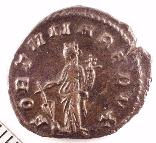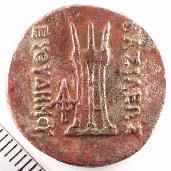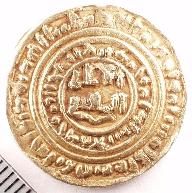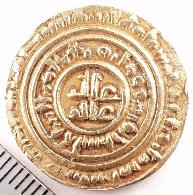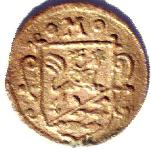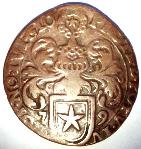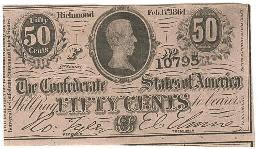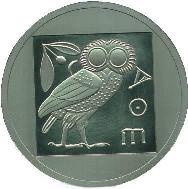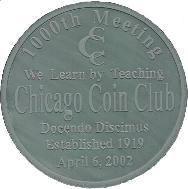Chatter
archive
also available
| Chicago Coin Club |
|---|
| Volume 48 No. 3 |
March 2002 |
|---|
Minutes of the 997th Meeting
Speaker's Wor[l]d
Learning from Early U.S. Mint Reports
Presented by
Paul Hybert
to our February 13, 2002 meeting.
Many specialized books and journals are available to the
collectors of the early US copper and silver coinage.
Although these published works rely heavily upon
such primary sources as internal Mint records now kept in government archives
in Philadelphia and Washington,
contemporary diaries and newspapers also provide many fascinating
stories of how people viewed their circulating money.
This program reviewed another source of mint information,
the Mint reports of the first hundred years.
The format of the reports evolved over time;
from a number of specialized reports issued during the year
up to the four hundred plus page annual reports by the 1890s.
At the risk of over simplification (and offending lawyers
by ignoring the judicial branch of the US government),
here is the structure of the US government:
Congress (the Legislative branch) passes a law,
and the President and cabinet (the Executive branch) implements the law.
Many laws place some reporting requirement upon some government department,
to report on either the ongoing operation of the department or
some special circumstance that Congress wishes investigated.
The first report shown was a photocopy of Paramount International Coin Corporation's
reprint of the 1796 mint report.
The first three pages trace this report's original path:
-
November 29, 1796 - from Mint Director Elias Boudinot
to the Secretary of State, intended for the President;
-
December 19, 1796 - from Secretary of State Timothy Pickering,
at the direction of President Washington, to the Speaker of
the House of Representatives;
-
December 20, 1796 - referred to Mr Page, Mr. Havens, and Mr. Goodrich;
-
February 13, 1797 - committed to a committee of the whole House, on Monday next;
-
December 8, 1797 - committed to a committee of the whole House, on Wednesday next.
Why would the Secretary of State be involved with a Mint report?
Because the Mint was a part of that department originally
(and the Coast Guard was part of the Treasury Department).
The early reports contain some recurring topics;
such as learning the business of running a Mint
while fending off Congress' attempts at privatizing the Mint.
The Mint officials were not stupid;
they were running the Mint under policies created by Congress,
and when a procedure was found to be awkward or inefficient
the Mint would petition Congress to change that procedure.
Consider this one example;
the mint was to give to a depositor the gold and silver
coins produced from that depositor's bullion,
but the Mint also was to keep pieces for examination of the Assay Commission.
This angered the depositors who did not receive the full coinage due to them.
An original of the sparse six-page report for 1816 was shown next.
The recent completion of a brick building, the recent substitution
of a steam-engine for horse-power,
and the increased bullion deposits presaged good things in the future.
It was better to look to to the future than dwell on a year in which
the Mint had expenses of $18,242 and produced only $56,785.57 in
silver and copper coins.
(However, it must be remembered that the War of 1812 had recently concluded.)
As with everything, time takes its toll on an institution's memory.
The original reports were published in small amounts for the country was still small;
many original members of Congress (from 1789) were gone;
and many copies of reports were lost.
Some efforts were made to correct this.
In 1813, Congress required the printing of its business papers;
starting in 1817, this Serial Set continues today.
In 1831, Congress decided to publish all of its old reports
in a set of volumes known as
American State Papers.
Co-edited by Walter Lourie, Secretary of the Senate,
and Matthew St. Clair of the House of Representatives,
the resulting 38 volumes were printed by Gales and Seaton of Washington,
from 1832 to 1861.
Material was grouped by topic into ten Classes,
with documents consecutively numbered within each volume.
Documents directly related to the Mint can be found in the
five volumes of Class 3 - Finance.
Most of the original edition of 750 sets,
with marbled boards and leather binding (and trim),
was given to Congress for distribution back home.
Although the original outside typically succumbed to the combination of
heavy use and
their large size (about 1000 pages in an 8½ by 13 inch volume),
the pages usually are sound but may show some toning.
The shown Volume 2 was still intact
but a number of pages had leaf shaped stains;
this poor volume had, at one time, been used to press tree leaves,
and a few leaves were still there.
The next few reports, from the 1840s and 1850s, were all
disbound from volumes of the Serial Set mentioned above.
For example, the report for 1853 consisted of 18 pages,
each 5½ by 9 inches in size, and was identified as
"33rd Congress, 1st Session, Ex. Doc. No. 40, of the
House of Repesentatives."
(The Ex. Doc. No. abbreviates Executive Document Number;
the documents were consecutively numbered within each session of Congress.
Each "congress" would meet for two one-year sessions.)
Up through 1856, each annual report covered one calendar year,
but starting with 1857, each report covered one government fiscal year.
Fiscal year 1863 started on July 1, 1862 and ended on June 30, 1863.
Although that made sense from a business standpoint,
it could confuse the unwary collector, who collected coins by calendar year;
the Mint the first spent half of FY 1863 minting
coins dated 1862, and the the last half minting coins dated 1863.
It would not be until late in the nineteenth century that the Mint would
publish tables showing coin production by calendar years in addition to fiscal year.
Originally, many short reports were issued during the course of a year,
often in response to a specific request from Congress.
A typical requested report showed the fineness and weights of
foreign gold and silver coins, along with their value in US money.
Recall that certain foreign coins were legal tender in the US
during the first half of the nineteenth century.
Congress used these reports to determine which foreign
coins were legal tender.
Although some collected reports from a given year are to be found,
it was not until 1873 that the first of the large reports (more than one hundred pages)
in black cloth covers would be produced.
Within 15 years, 400-page reports would be the norm,
filled with many types of information.
A number of reucurring themes appear in the reports of the first hundred years.
It is fascinating to see how the increasing US domestic gold production
impacted the Mint.
Nearly a third of the two-page report for 1829 was spent
reviewing it,
from the first $11,000 of North Carolina gold received in 1804
up to the "remarkable increases" culminating in the $128,000 received in 1829.
The resulting strains placed on the Mint would be repeated on a larger
scale after 1848 with California gold the cause.
(California gold would be coined into more than $200,000,000
by the end of 1853.)
The talk concluded with just two of the many interesting pieces
to be found in the reports.
First was a table from 1863,
showing the number of old Large Cents annually returned to the mint
starting in 1857 when the first small cents were minted
(very sad for this EAC member).
Second was about the San Francisco mint in the 1886 report;
describing how, after seven years of service,
the old carpet in the planchet adjusting room had been torn up, burned, and refined
to produce about 172 ounces of gold and 44 ounces of silver.
A project to put the early Mint reports onto the web is still
in its early stages, and is at
http://www.ece.iit.edu/~prh/coins/lib/usmnt/mr.html.
http://www.chicagocoinclub.org/lib/us/usmnt/mr.html.
Read and enjoy!
Show and Tell
Each image has a scale in the lower-left corner,
with the tics spaced 1 mm apart.
Because the brightness and contrast were manipulated on a computer,
the coloring of a coin's image differs from the coin's actual coloring.
-
Sharon Blocker
started the program by discussing one of her favorite topics, bi-metalic coins.
Although a few such pieces were struck through the years,
it was only within the last 20 years that the production of bi-metalic
and even tri-metalic coins became common around the world.
The pieces of different metals are made sparately,
and it is the actual coin striking process which forces the parts together
while transferring the design.
A very striking design is on the 12-sided 25 kuna piece
from Croatia.
Dated 2000, the baby-in-womb design signifies the rebirth of the country.
-
Ancient coins of the Parthians and Sakas were brought by
Bob Weinstein:
-
Imitation of Parthian drachm of Phraates III. Struck by local Saka rulers
in Eastern Iran and Pakistan.
The coin was countermarked by Tanlis Mardates, a Saka king, possibly ruler of the
Sakaraukai.
The countermark is inscribed with the king's name in Greek (TANLHC) and has a
bust facing left wearing a hat.
For nearly one hundred years the name had been misread as Otannes
(OTANNHC). This mistake
was due to a round ball which is part of the hat which was misread as
O. Despite better quality specimens
coming to light over the years no one challenged the original reading
for 92 years.
Tanlis countermarked Parthian drachms and local copies for many years before
commencing a coinage of his own.
The countermarking probably began in the reign of Phraates III (70-57
BCE) and continued into the reign
of Phraates IV (38-2 BCE). Imitation Phraates III drachms are the most
common of the countermarked coins.
The countermarked drachms of Phraates IV are the rarest being known from only two
examples.
The coinage Tanlis issued in his own name is quite scarce and probably
was struck for a short period
at the end of the first century BCE.
-
Parthian drachm of Phraates IV, countermarked by Tanlis Mardates.
Note the eagle behind the bust.
This is one of two known examples.
-
Drachm of Tanlis Mardates with Lady Raggodeme.
Obverse portrays bust of Tanlis right wearing distinctive Saka helmet
with streamers.
Reverse portrays bust of Lady Raggodeme right. Legends on both sides are
in Greek.
-
Imitation of a drachm of Phraates IV of Parthian with false countermark engraved
in the die.
These were struck by local Saka rulers in N/W Iran and Central Asia.
Probably contemporary with the coins they imitated. (38-2 BCE)
-
Tetradrachm of the Saka King Vonones with his nephew Spalagadames as
co-ruler.
Vonones ruled a kingdom in Afghanistan and is only known from his coins.
Since there are no historical references to him only an approximate date
for his rule can be given (75-65 BCE).
Tetradrachms of Vonones with Spalagadames are scarce. This particular one
has a rare control mark. It is one of only two known examples.
The obverse portrays the king on horseback with lance with Greek legend.
The reverse portrays Zeus standing holding scepter and thunderbolts with
Kharosthi legend.
-
Carl Wolf
brought in a variety of items.
-
After learning about it in last year's CICF handout,
Carl saw obsidian mentioned in a number of places,
even in the October issue of National Geographic.
-
A prototype of the ANA Presidential Award,
featuring an encased priting of the History Instructing Youth
vignette originally on 1896 US paper money.
-
His latest installment in his displays of Odd and Curious money
shows the beautiful antique game counters
hand-carved from mother-of-pearl. They were
made into ovals, rectangles, circles, squares and even
fish shapes. The earliest counters were made about 1730 -
1770 and were plain with little decoration.
Made in China they were exported as early as
the 1700s to the Europe and America. They appear on
the ship manifest of the merchant ship Empress of
China that returned to New York and Philadelphia in
1785 after her maiden voyage to Canton.
By the early 19th century thicker shells were used
to accommodate more elaborate engravings. Pierced
borders were introduced in the early 1800s.
Counterfeiting was very difficult so by the late
19th century some private casinos used mother-of-pearl
tokens.
-
Eight coins featuring the "grandmother of Europe" were brought by
Steve Huber.
When queen Victoria died in 1901 at 81 years of age,
she was, through her nine children and many grandchildren,
related to most of Europe's crowned heads of state.
The coins shown were:
-
Seven proof patterns of 1848 florins.
There are 30 types known, consisting of 27 regular patterns
and three mules of various reverse pairs.
Here are three of his proof florins.
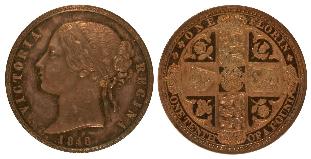 ESC 888
ESC 888
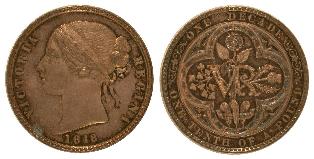 ESC 903
ESC 903
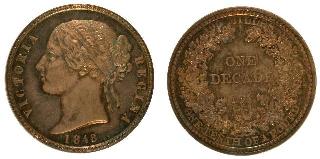 ESC 909
ESC 909
-
A proof 1847 gothic crown.
Although most pieces are known with marks from misguided attempts
at polishing and cleaning,
this darkly toned piece shows no scratches or hairlines.
 ESC 288
ESC 288
Steve then admitted to having problems making good pictures of coins with a digital camera,
and would like to share ideas and discuss the matter with other photographers.
-
Mark Wieclaw
showed some ancient and modern items.
-
A rare denarius of Gallienus (253-268).
Usually antoninianni are encountered from this emperor.
-
A dichalkon of Euthydemos II of Baktri (190-171 B.C.);
this is the only ancient coin with a significant nickel content (about 30%).
-
A dark, ugly, and unmarked bar of 0.897 fine silver,
weighing more than 100 ounces.
A US government produced bar from 1968,
it was used to redeem silver certificates.
-
At a recent local auction,
Mike Metras
found himself on the sideline while US coins were selling
for high, not reasonable price.
And then there were two pieces of fractional currency.
-
A three cent note from the 3rd series, in 1864.
-
A fifty cent Confederate note of 1864.
-
During his 2000 trip to Syria,
Bob Leonard
visited a collector in Aleppo.
Bob was given this gold coin, weighing 3.814 grams,
and was asked to identify it.
The curator of Islamic coins at the British Museum could not identify it,
but Michael Bates of ANS identified it.
Described in detail by a contemporary writer,
it was minted in Damascus for a few years starting in 530 AH.
Originally produced of seven eighths pure gold and one eighth silver and copper,
the ANS has only a fake, a gold plated copper piece.
-
Bill Swoger
showed a variety of medals.
-
A large oval bronze medal, made in Hungary to honor veterans of World War I.
-
A gold medal from the 1962 Seattle World's Fair.
-
An award medal from the 1893 Columbian Exhibition.
Awarded to George Whitting for displaying Indian corn of all varieties,
Bill conjectured that its pristine condition may be due to disgust;
the roster of the fair's medal winners lists his name as Whiting,
and who wants to show a medal with his name misspelled?
-
Bob Feiler
started by telling of his enjoyable trip to Paul Bosco's shop while in New York recently.
He then continued his exhibiting theme of objects made from coins:
-
1887 British Double Florin, enameled in six different colors
and mounted on a pin.
-
1845 British Crown, enameled in five different colors and
mounted on a pin.
-
1797 British two pence box coin.
-
1 3/4 inch diameter box medal marked Roma;
made of tin, showing Romulus and Remus on one side.
Containing 18 black
& white sepia toned very early (late 1800s) photos of Rome and famous
sites.
-
Coin (stack) box made to look like a stack of eight French
five franc coins. Obverse inscribed Liberty Equality and Fraternity.
Reverse
appears to be like a coin and is dated 1875.
Acquired on eBay, Bob thanked the club member who told him of the item.
-
Very small (5/8-inch X 1-inch) brass book which, when opened up,
reveals 8 black & white prints of Napoleonic scenes.
-
Last month,
Don Dool
showed the first pieces in his South American scripophily collection.
He started this month by showing the fifth piece in that collection,
a certificate for 20 pesos gold dated 1 July 1899 at Montevideo.
One of 1000 issued for Mineria Uruguay, it has four revenue stamps on back.
He then showed some medieval copper pieces:
-
Anhalt, 1621, Pfennig, Mann 175.
(J. Mann.
Anhaltische Münzen und Medaillen von Ende des 15 Jahrhunderts bis 1906,
Hannover, 1907).
-
Mansfeld-Vorderortische, 1622, 3 Pfennig, Tornau 467.
(Tornau, Otto. Prague, 1937).
-
Maestricht - siege, 1579, 8 Sols, Attributions: Duby VIII, 5; Mailet pg.
298, #3.2; Neumann II 12643.
Obv: Plumed helmet atop shield dividing date, 79. PROTEge Domine POPVlvm
TVvm PROPter NOminis TVI GLOriam. (Protect, o Lord, your people for the
glory of your name).
Rev: Hand holding sword. TRAIECto AB HIS PAN IS OBS ESS (Besieged by the
Spaniards necessity), value VIII below.
Duby references his information on this piece to the cabinet of M.
Aumont. Values of XXXX, XXIIII, II and I sols also struck, all in
copper.
1000th Meeting Announcement
On April 6, 2002 the Chicago Coin Club will celebrate its 1000th meeting! This is a
milestone few clubs achieve and we're planning to celebrate it in grand style!
The celebration will be held in conjunction with the Chicago International Coin Fair,
April 5-7, Holiday Inn O'Hare, 5440 North River Road, Rosemont, IL and various memorabilia
are planned.
The following medals will be issued to honor the occasion:
-
A .999 fine 5-ounce silver medal ($48 + $11 for registered mail).
-
A .999 fine 5-ounce silver medal with gold highlights ($63 + $11 for registered mail).
(Available only by orders with payment received by March 15.)
-
and a 24-karat
8-ounce (approx.) gold medal ($2700.00 + $15 for registered mail).
The price is based upon gold at $297 per ounce when the club orders the medals from the mint;
price adjustments will be made.
(Available only by orders with payment received by March 15.)
We'll hold a 1 PM meeting with Steve Album as the featured speaker who will speak
on The Development of Islamic Coinage, 650 - 1250 AD. In keeping with tradition, the Club
will present everyone who attends a handout dealing with primitive money. This year it will be
the story of Gold Dust Money and it will include a few flakes of genuine gold!
The activities will culminate that evening at a banquet held in the hotel. A fabulous menu
is planned and the featured speaker will be Dr. Ute Wartenberg, Executive Director of the
American Numismatic Society, New York. She will speak on Owls to Athens - The Dollar of
the Ancient World. Banquet tickets are sold on a reservation basis and are available at $45.
A cash bar will open at 6 PM, and the banquest will start at 7 PM.
The menu is a choice of Grilled Herb Marinated Salmon,
or Citrus Marinated Grilled Breast of Chicken;
please make checks payable to "Chicago Coin Club"
and mail them, along with your menu choice, to
the club's P.O. Box listed below.
Please don't wait until April 6th to buy a ticket - it may be too late. Check out our Web site
www.chicagocoinclub.org for latest updates.
Each guest will receive a special parking pass with a reduced rate of $6,
instead of $11, good at the hotel parking lot.
A souvenir program is also planned that we feel collectors will keep for years to come.
Everyone at the banquet will receive one and copies will be mailed to the Club members who
couldn't attend. They'll also be made available to every new member for years to come. It will
include an updated history of the Club, the descriptive list of medals issued with photos, a roster
of the Past-Presidents, Medal of Merit Recipients and the Club's Constitution and By-Laws.
-
The organizing committe decided upon two methods of support.
Congratulatory advertisements in the souvenir program are available
at: full page $100, half page $50 and quarter page $25.
-
Also, the souvenir program will recognize those Patrons who helped support the day's events.
The available levels of Patron support are:
Platinum $500, Gold $100, Silver $25 and Bronze $10.
-
To ensure that you're properly recognized in this project, please be sure we have your
response by March 15, 2002. It should be mailed to Chicago Coin Club, P.O. Box 2301,
Chicago, IL 60690.
Our 998th Meeting
| Date: | March 2, 2002 |
| Time: | 1:00 PM |
| Location: | 8th Annual Chicago Paper Money Expo (CPMX)
at the Holiday Inn O'Hare, 5440 North River Road, Rosemont.
Admission to the meeting is free, but admission to the show is $5.
|
Featured
speaker: | Fred Schwan
- New Discoveries in Military Payment Certificates
Originally published in 1980, Fred Schwan's
Comprehensive Catalog of Military Payment Certificates
just had its fourth edition released.
So many new discoveries have been uncovered that it includes 108
additional pages over the third edition.
Join us as Schwan will reveal new research and tell stories of these new findings.
He is also donating three copies of his new book to be used as door prizes.
For the seventh consecutive year, the Chicago Coin Club will present everyone in
attendance with a souvenir card dealing with Chicago numismatic history. This year the
National Bank Notes of the First National Bank of Chicago will be covered.
|
Our 999th Meeting
| Date: | March 13, 2002 |
| Time: | 7:00 PM |
| Location: | Downtown Chicago - Please remember
the security measures at our meeting building:
give a club officer the names of all your guests prior to the meeting day,
and everyone must have a photo-ID. |
Featured
speaker: | Sharon Blocker
- I've Been Working on the Railroad
Although her railroad collection started about 20 years ago
with paper items such as postcards, books, and other exonumia,
the collecting bug bit again when
Sharon encoutered railroad themed world currency at a currency show.
She has since started a
collection of world currency and coins with railroads on them.
Sharon will
take you around the globe and show you her examples of railroadania.
The title "I've been working on the railroad", means that this is still a work
in progress.
|
Important Dates
| March |
1-3 |
8th Annual Chicago Paper Money Expo (CPMX)
at the Holiday Inn O'Hare, 5440 North River Road, Rosemont.
Admission is $5. |
| March |
2 |
998th CCC Meeting - 1pm at the Chicago Paper Money Exposition,
which is held at the Holiday Inn O'Hare, 5440 N. River Road, Rosemont, IL.
No admission charge for our meeting.
Featured Speaker - Fred Schwan on
New Discoveries in Military Payment Certificates. |
| March |
13 |
999th CCC Meeting - Featured Speaker Sharon Blocker on
I've Been Working on the Railroad |
| March |
16 |
Windy City Chip Show (Gaming chips and tokens)
at the Elmhurst Holiday Inn, I-290 at York Road.
Open from 9am until 4pm; 10-15 chip dealers expected.
Admission is $5.
For more information, contact Joel Reznick at 847-971-7764.
|
| April |
5-7 |
27th Annual Chicago International Coin Fair (CICF)
at the Holiday Inn O'Hare, 5440 North River Road, Rosemont.
Admission is $5. |
| |
|
Our April meeting will consist of two sessions on the same day:
an afternoon session and an evening (banquet) session. |
| April |
6 |
1000th CCC Meeting (session #1) - 1pm at the Chicago International Coin Fair (CICF),
which is held at the Holiday Inn O'Hare, 5440 North River Road, Rosemont, IL.
No admission charge for our meeting.
Featured Speaker - Steve Album on
The Development of Islamic Coinage, 650 - 1250 AD. |
| April |
6 |
1000th CCC Meeting (session #2) -
Banquet meeting at the Holiday Inn O'Hare, 5440 North River Road, Rosemont, IL.
Reservations ($45 per person) required.
Featured Speaker - Dr. Ute Wartenberg, Executive Director of the American Numismatic Society, on
Owls to Athens - The Dollar of the Ancient World. |
| June |
28-30 |
21st Annual MidAmerica Coin Expo
at the Donald E. Stephens Convention Center, 5555 North River Road, Rosemont.
Admission is $5.
|
Birthday and Year Joined
| April |
1 |
Charles J. Ryant, Jr. |
|
| April |
12 |
Mark Wieclaw |
1991 |
| April |
15 |
Robert D. Leonard, Jr. |
1983 |
| April |
15 |
Charles Menard |
1995 |
| April |
18 |
Nancy Walsh |
1997 |
| April |
27 |
Don Valenziano |
1982 |
Chatter Matter
All correspondence pertaining to Club matters
should be addressed to the Secretary and mailed to:
CHICAGO COIN CLUB
P.O. Box 2301
CHICAGO, IL 60690
Visit Our Web Site
http://www.ChicagoCoinClub.org/
Contacting Your Editor
Paul Hybert
ECE Dept, IIT
3301 S. Dearborn
Chicago, IL 60616 |
| prh@ece.iit.edu |
| 1-312-567-3976 |
Club Officers
| Carl Wolf | - President |
| Robert Feiler | - First Vice President |
| Donald Dool | - Second Vice President |
| |
| Directors: | Lyle Daley
William Burd
Jeff Rosinia
Mark Wieclaw |
| |
| Other positions held are: |
| Lyle Daley | - Secretary Treasurer |
| Paul Hybert | - Chatter Editor |
| Phil Carrigan | - Archivist |


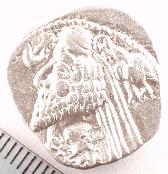


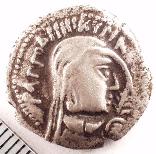
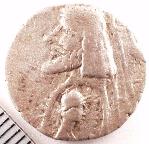
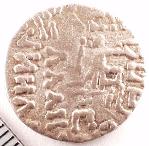
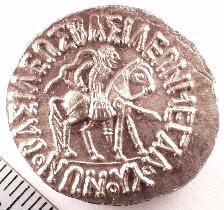
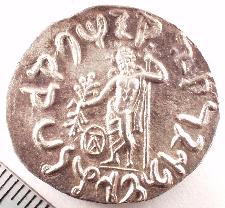
 ESC 888
ESC 888
 ESC 903
ESC 903
 ESC 909
ESC 909
 ESC 288
ESC 288

